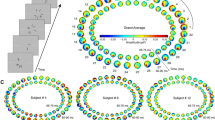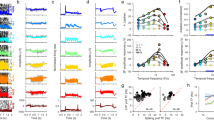Summary
We investigated the hemispheric distribution of the rat visual evoked potential (VEP) to pattern reversal and flash stimuli, presented monocularly at a rate of 1 Hz. Pattern VEP components could be recorded only over an area bounded by the anatomical coordinates of area 17, while some flash VEP components were recordable outside the primary visual area. Monocular pattern stimulation, as expected, evoked dominant contralateral VEPs. Surprisingly, ipsilateral responses could be also recorded with the reference electrode near the nasal bone. These VEPs showed partial polarity inversion compared to the contralateral EPs. To assess the origin of the ipsilateral EPs, we also recorded EPs following surgical deafferentation of the ipsilateral cortex. Our data reveal that ipsilateral VEPs represent volume conducted potentials.
Similar content being viewed by others
References
Adams AD, Forrester JM (1968) The projection of the rat's visual field on the cerebral cortex. Quart J Exp Physiol 53: 327–336
Barrett G, Blumhardt L, Halliday AM, Halliday E, Kriss A (1976) A paradox in the lateralization in the visual evoked response. Nature 261: 253–255
Blumhardt LD, Barrett G, Kriss A, Halliday AM (1982) The pattern-evoked potential in lesions of the posterior visual pathways. Ann NY Acad Sci 388: 264–289
Boyes WK, Dyer RS (1983) Pattern reversal visual evoked potentials in the awake rat. Brain Res Bull 10: 817–823
Camisa J, Bodis-Wollner I (1982) Stimulus parameters and visual evoked potentials diagnosis. Ann NY Acad Sci 388: 645–647
Creel D, Dustman RE, Beck EC (1974) Intensity of flash illumination and the visually evoked potential of rats, guinea pigs and cats. Vision Res 14: 725–734
Creutzfeldt OD, Watanabe S, Lux HD (1966) Relations between EEG phenomena and potentials of single cortical cells. Electroencephalogr Clin Neurophysiol 20: 1–18
Dyer RS, Howell WE, McPhail RC (1980) Dopamine depletion slows retinal transmission. Exp Neurol 71: 326–340
Halliday AM, Mushin J (1980) The visual evoked potential in neuroophthalmology. In: Sokol S (ed) Electrophysiology and psychophysics: their use in ophthalmic diagnosis. Little, Brown and Co, Boston, pp 155–183
Halliday AM, (1982) Evoked potentials in clinical testing. Churchill Livingstone, Edingburgh
Harnois C, Bodis-Wollner I, Onofrj M (1984) The effect of contrast and spatial frequency on the visual evoked potential of the hooded rat. Exp Brain Res 57: 1–8
Holder GE (1978) The effects of chiasmal compression on the pattern visual evoked potentials. Electroencephalogr Clin Neurophysiol 45: 278–280
Hughes A (1977) The refractive state of the rat eye. Vision Res 17: 927–939
Konig JFR, Klippel RA (1963) The rat brain, a stereotaxic atlas of the forebrain and lower parts of the brain stem. Williams and Wilkins, Baltimore
Kuroiwa Y, Celesia GG (1981) Visual evoked potentials with hemifield pattern stimulation. Their use in diagnosis of retrochiasmal lesions. Arch Neurol 38: 66–90
LeVere TE (1978) The primary visual system of the rat: a primer of its anatomy. Physiol Psychol 6: 142–169
Mallecourt J, Verlay R (1977) Etude compare des projections somethesiques et visuelles sur le cortex cerebral du rat adulte normal, du rat enuclee des yeux a la naissance et du rat jeune. Electroencephalogr Clin Neurophysiol 42: 785–794
Meyer GE, Salinsky MC (1977) Refraction of the rat: estimation by pattern evoked visual cortical potentials. Vision Res 17: 883–885
Milkman N, Schick G, Rossetto M, Ratliff F, Shapley R, Victor J (1980) A two-dimensional computer-controlled visual stimulator. Behav Res Methods Instr 12: 283–292
Miller M (1981) Maturation of rat visual cortex. I. A quantitative study of Golgi-impregnated pyramidal neurons. J Neurocytol 10: 859–878
Montero VM (1973) Evoked responses in the rat's visual cortex to contralateral, ipsilateral and restricted photic stimulation. Brain Res 53: 192–196
Nunez PL (1981) Electric fields of the brain. Oxford University Press, New York
Onofrj M, Bodis-Wollner I, Bobak P (1982a) Pattern visual evoked potentials in the rat. Physiol Behav 28: 227–230
Onofrj M, Bodis-Wollner I, Mylin L (1982b) Visual evoked potential diagnosis of field defects in patients with chiasmatic and retrochiasmatic lesions. J Neurol Neurosurg Psychiat 45: 294–302
Onofrj M, Bodis-Wollner I (1982) Dopaminergic deficiency causes delayed visual evoked potentials in rat. Ann Neurol 11: 484–490
Pollen, DA (1969) On the generation of neocortical potentials. In: Jasper HH, Ward AA, Pope L (eds) Basic mechanisms of the epilepsies. Little, Brown and Co., Boston, pp 411–420
Rowe MJ (1982) The clinical utility of half-field pattern reversal visual evoked potential testing. Electroencephalogr Clin Neurophysiol 53: 73–77
Saxton PM, Siegel J (1983) Visual evoked potentials to light flash in cats: is a frontal sinus reference electrode truly indifferent? Electroencephalogr Clin Neurophysiol 55: 349–354
Somogyi P (1978) The study of Golgi stained cells and experimental degeneration under the electron microscope: a direct method for the identification in the visual cortex of three successive links in a neuron chain. Neuroscience 3: 167–180
Wildberger HGH, Van Lith GHM, Wiengaard R, Mak GTM (1976) Visually evoked cortical potentials in the evaluation of homonymous and bilateral visual field defects. Br J Ophthalmol 60: 273–278
Wood CC (1982) Application of dipole localization methods to source identification of human evoked potentials. Ann NY Acad Sci 388: 139–155
Author information
Authors and Affiliations
Rights and permissions
About this article
Cite this article
Onofrj, M., Harnois, C. & Bodis-Wollner, I. The hemispheric distribution of the transient rat VEP: a comparison of flash and pattern stimulation. Exp Brain Res 59, 427–433 (1985). https://doi.org/10.1007/BF00261332
Received:
Accepted:
Issue Date:
DOI: https://doi.org/10.1007/BF00261332




